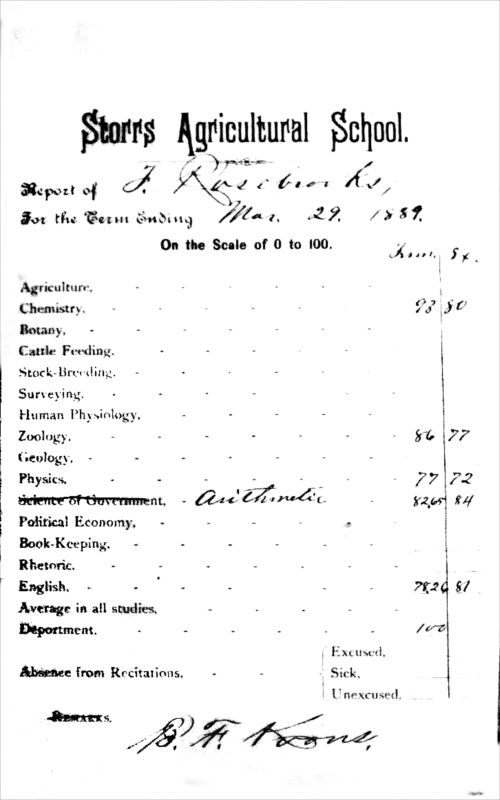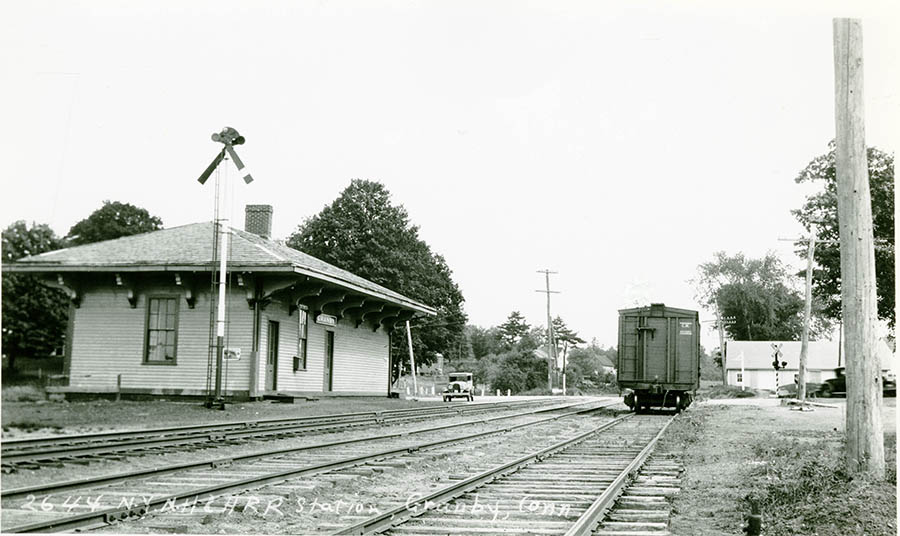As a University of Connecticut alum, I can think back to a handful of trips to the Thomas J. Dodd Research Center while working on projects and papers as an undergraduate. Back in June, I set foot in the stacks of the Archives and Special Collections Department for the first time as I interviewed for the position of Archivist Assistant for the U. Roberto (Robin) Romano Papers. I was introduced to the side of the ASC that students don’t typically get to see, and was presented with a literal mountain of material that would soon become my charge. Continue reading
Category Archives: What’s Happening in the Archives
Human Rights, Children’s Literature, and the Art of Youth Activism
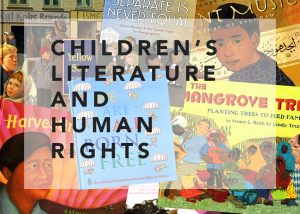 Join us for the presentation of the 2016 Raab Associates Prize and a discussion of Human Rights, Children’s Literature, and the Art of Youth Activism featuring Professor Jonathan Todres, Author of Human Rights in Children’s Liteature: Imagination and the Narrative of Law (Oxford University Press, 2016), Pegi Deitz Shea, author of numerous books for young people including Abe in Arms (PM Press, 2010) and The Carpet Boy’s Gift (Tilbury House, 2003), and Reven Smith Spoken word poet, musician, writer, social activist, and UConn student.
Join us for the presentation of the 2016 Raab Associates Prize and a discussion of Human Rights, Children’s Literature, and the Art of Youth Activism featuring Professor Jonathan Todres, Author of Human Rights in Children’s Liteature: Imagination and the Narrative of Law (Oxford University Press, 2016), Pegi Deitz Shea, author of numerous books for young people including Abe in Arms (PM Press, 2010) and The Carpet Boy’s Gift (Tilbury House, 2003), and Reven Smith Spoken word poet, musician, writer, social activist, and UConn student.
TODAY, November 10, 2016
4:00pm to 6:00pm
Konover Auditorium, Thomas J. Dodd Research Center
University of Connecticut
Public reception to follow. Directions to the Dodd Research Center and event details can be found at Thomas J. Dodd Research Center Events.
ABOUT THE RAAB PRIZE:
The Raab Associates Prize has been given since 1999 to give University of Connecticut students the opportunity to learn about illustrating for children and the children’s literature field. The competition was created and sponsored by Susan Salzman Raab, founder and co-owner of Raab Associates, a children’s book marketing agency based in Swarthmore, Pennsylvania.
This year, for the first time, the prize has focused on human rights, and specifically children’s rights, and represents a joint effort between UConn’s Thomas J. Dodd Research Center and the School of Fine Arts. Ms. Raab, who is also a 1980 UConn alumna with a degree in English, especially wants to encourage and support people who have interests in the arts and in human rights. The competition is held annually and the prize is awarded to students enrolled in the University of Connecticut’s School of Fine Arts’ illustration courses.
Talk Today: Our Rivers on Drugs – Pharmaceuticals and Personal Care Products as Agents of Ecological Change
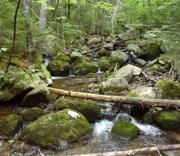 Today at 4:00pm, UConn’s Edwin Way Teale Lecture Series on Nature and the Environment presents Our Rivers on Drugs: Pharmaceuticals and Personal Care Products as Agents of Ecological Change in Aquatic Ecosystems, a talk by Dr. Emma Rosi-Marshall, Senior Scientist at the Cary Institute of Ecosystem Studies in Millbrook, New York.
Today at 4:00pm, UConn’s Edwin Way Teale Lecture Series on Nature and the Environment presents Our Rivers on Drugs: Pharmaceuticals and Personal Care Products as Agents of Ecological Change in Aquatic Ecosystems, a talk by Dr. Emma Rosi-Marshall, Senior Scientist at the Cary Institute of Ecosystem Studies in Millbrook, New York.
Dr. Rosi-Marshall’s research focuses on land-use change and restoration, agriculture, hydropower, and urbanization and their impact on freshwater ecosystems. Her studies recently published, and covered by CNN, investigate the impact of pharmaceutical and personal care product pollution on our nation’s freshwaters. These include an array of contaminants and compounds that are often not removed by wastewater treatment facilities, from prescription medications and over-the-counter drugs to the antimicrobials found in detergents and cosmetics. When they enter streams and rivers from our households, they can harm aquatic life and compromise freshwater quality.
In her talk, Dr. Rosi-Marshall will discuss her research and outline what is needed to combat the growing problem. Join us today,Thursday, November 3, 4:00 pm, in Konover Auditorium, at the Dodd Research Center.
The Edwin Way Teale Lecture Series, named for Pulitzer-Prize-winning author and naturalist Edwin Way Teale whose papers, photographs, and publications are preserved in Archives and Special Collections, brings leading scholars and scientists to the University of Connecticut to present public lectures on nature and the environment. All lectures are free, open to the public
Women of the Black Panther Party
The following post is by undergraduate and UConn History Department intern Maggie Peyton about her current project working with materials in the Archives & Special Collections.
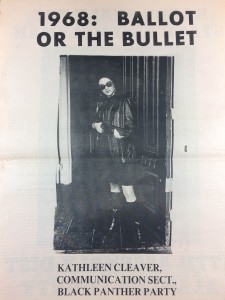 My name is Maggie Peyton. I am a sophomore here at UConn, majoring in business. I took this opportunity to do research at the Archives & Special Collections because I am very interested in social justice and its history in the U.S. Prior to this internship, I had not taken any history classes on campus or engaged in archival work, so this is a very new and interesting experience.
My name is Maggie Peyton. I am a sophomore here at UConn, majoring in business. I took this opportunity to do research at the Archives & Special Collections because I am very interested in social justice and its history in the U.S. Prior to this internship, I had not taken any history classes on campus or engaged in archival work, so this is a very new and interesting experience.
The objective of this internship is to create an exhibit for the archives for the month of December. My fellow intern and I will be constructing an exhibit about minority women in the Civil Rights/social justice movements of the twentieth century. Specifically, I am focusing on the role of black women. What we know as the Women’s Movement was historically very exclusive and only served to represent upper-class white women. It did not acknowledge nor advocate for the issues unique to women who did not belong to this category. Continue reading
Black Experience in the Arts: Poet and Activist Jayne Cortez
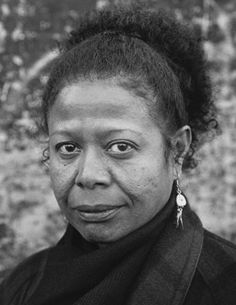 Guest blog post by Marc Reyes, doctoral student at the University of Connecticut and 2016 Summer Graduate Intern in Archives and Special Collections.
Guest blog post by Marc Reyes, doctoral student at the University of Connecticut and 2016 Summer Graduate Intern in Archives and Special Collections.
If you think poetry recitals are dull, then you haven’t heard Jayne Cortez read her work. Her poem, “Dinah’s Back in Town” (dedicated to blues singer Dinah Washington), begins:
“You know, I want to be bitchy. I said I want to be a bitch. Cause when you’re nice, true love don’t come into your life. You get mistreated, mistreated and abused by some no good man who don’t care nothing about no blues.”
After declaring that “…true love don’t come into your life,” the audience laughed and hooted their approval of the sentiment. The rest of Cortez’s tribute to Dinah Washington cautioned about the promises fast-talking men make to women. And if women struggled to find the courage to stop shady men in their tracks, they only need to look to the titular heroine for inspiration. Cortez described Washington as an assertive, tough-as-nails woman with no patience for schemers and scoundrels. And when a bad man comes around, just tell him, “Dinah’s back in town.”
Cortez read this and several others poems on May 12, 1972. This 1972 performance was the first of a dozen individual visits she made to the University of Connecticut. Her twelve trips to Storrs were all for the same reason: she was invited to speak to the undergraduates enrolled in the School of Fine Arts course, Black Experience in the Arts. The class, which operated under this title for over two decades, heard directly from a variety of talented musicians, actors, dancers, singers, artists, and writers. Cortez was an ideal candidate to speak to UConn students. Her acclaimed poetry and spoken word performances, often with musical accompaniment, made her a leading figure in the Black Arts Movement of the late 1960s and early 1970s. Besides her considerable talents as a writer, Cortez was also a teacher, a publisher, founder of Los Angeles’ Watts Repertory Theater Company, and an activist who dedicated her adult life to ending racial and gender discrimination in American society.
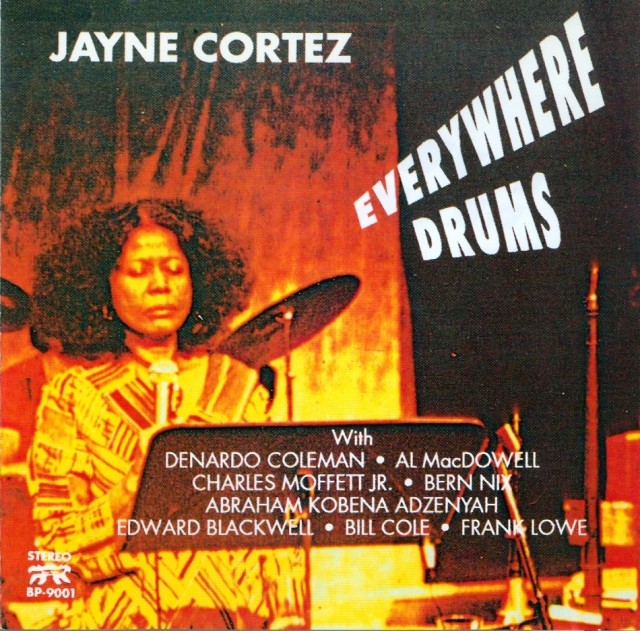 When Cortez spoke in the spring of 1972, she read selections from her 1971 poetry collection, Festivals and Funerals. The delivered poems touched on ideas about loneliness, anger, and love. Others addressed how black Americans adjusted to living in northern cities compared to life in the rural South. Another, “Watching a Parade in Harlem,” described the frenzy generated by a local Harlem parade and compared the appearance of many New York City policemen to a colonizing force. Her tribute to Dinah Washington was not the only work that addressed struggles women encounter. Her composition, “I Am a Worker,” was dedicated to “all my sisters in the garment industry.” The women depicted in this poem are garment workers who toil under harsh conditions for low pay. Her words make vivid the swollen legs, stiff hands, and back-breaking labor these women undertake in pursuit of “survival money.” After listing the many bills and fees that make “survival money” less a reality and more a dream, the narrator asks, “Do you think a revolution is what I need?”
When Cortez spoke in the spring of 1972, she read selections from her 1971 poetry collection, Festivals and Funerals. The delivered poems touched on ideas about loneliness, anger, and love. Others addressed how black Americans adjusted to living in northern cities compared to life in the rural South. Another, “Watching a Parade in Harlem,” described the frenzy generated by a local Harlem parade and compared the appearance of many New York City policemen to a colonizing force. Her tribute to Dinah Washington was not the only work that addressed struggles women encounter. Her composition, “I Am a Worker,” was dedicated to “all my sisters in the garment industry.” The women depicted in this poem are garment workers who toil under harsh conditions for low pay. Her words make vivid the swollen legs, stiff hands, and back-breaking labor these women undertake in pursuit of “survival money.” After listing the many bills and fees that make “survival money” less a reality and more a dream, the narrator asks, “Do you think a revolution is what I need?”
Cortez continued speaking to the Black Experience in the Arts course over the next twelve years, her visits becoming almost an annual occurrence. Her lectures did not recycle content or repeat poems because she was producing so much new and original work. Between the years of 1972 to 1984, Cortez released four books of poetry, five spoken word recordings, and founded the publishing company, Bola Press. But there was more to Jayne Cortez than her work and in a February 1984 lecture, she discussed more personal matters including her childhood, her first battles against racial injustice, and her decision to became a writer.
In this lecture, students learned about Cortez‘s birth in Arizona and growing up in postwar Los Angeles. She recounted how she studied to be an actress and then a director, but found writing to be her true calling. While studying art, music, and drama in high school and college, Cortez became involved in the civil rights movement. In the early 1960s, she spent two summers working for the Student Nonviolent Coordinating Committee (SNCC), registering black voters in Mississippi. She told students that this edifying work inspired her to produce art, infused with integrity, which mixed “political language with the poetic.”
 After explaining how her writing career started, Cortez informed students about the opportunities a writing career can produce. Because of her success, she received invitations to speak at international poetry festivals throughout Europe and Africa. She described the artistic affirmation experienced by performing at Carnegie Hall or having her books reviewed in The New York Times or The Washington Post. Lastly, Cortez concluded her presentation by bringing to the stage her band, the Firespitters, who provided musical accompaniment to her poetry. Cortez’s use of music to emphasize her work was not a gimmick; Cortez and the Firespitters played together for over three decades and released thirteen albums. By incorporating music into the reading of her poetry, Cortez became a pioneer in the field of poetic performance art.
After explaining how her writing career started, Cortez informed students about the opportunities a writing career can produce. Because of her success, she received invitations to speak at international poetry festivals throughout Europe and Africa. She described the artistic affirmation experienced by performing at Carnegie Hall or having her books reviewed in The New York Times or The Washington Post. Lastly, Cortez concluded her presentation by bringing to the stage her band, the Firespitters, who provided musical accompaniment to her poetry. Cortez’s use of music to emphasize her work was not a gimmick; Cortez and the Firespitters played together for over three decades and released thirteen albums. By incorporating music into the reading of her poetry, Cortez became a pioneer in the field of poetic performance art.
This summer, additional Jayne Cortez lectures debuted on the Archives and Special Collections digital repository. Now, six of Cortez’s twelve Black Experience in the Arts lectures can be easily accessed online with plans to digitize the rest. In addition, Archives and Special Collections possesses physical copies of Cortez’s work in book and audio form. For scholars interested in poets like Jayne Cortez or the broader Black Arts movement, Archives and Special Collections has many resources available to researchers. Stay tuned as we continue to make these valuable materials more widely known and available as well as additional blog posts highlighting other prominent lecturers who visited the university and spoke to Black Experience in the Arts students.
Marc Reyes is a doctoral student in the Department of History at the University of Connecticut. He received his B.A. in History from the University of Missouri and his M.A., also in History, from the University of Missouri-Kansas City. His research investigates the United States and its interactions – diplomatically, economically, and culturally – with India. As a 2016 graduate intern, Marc is excited to gain additional experience working in a university archive and will be exploring the history of the Black Experience in the Arts course here at UConn as well as the broader movement of 20th century black expression in the arts.
Chasing History through Annotations
The following guest blog post is by Daniel Allie, a 2014 graduate of the University of Connecticut’s English Program. While a student, Mr. Allie worked in Archives and Special Collections for two years as a Student Library Assistant. Since graduation, he has turned to the field of History, and volunteers his time at the Mansfield Historical Society and the Connecticut Historical Society as well as researching and writing pieces like this one for Archives and Special Collections.
What can a book tell you?
Quite a lot, though not necessarily in the way you would immediately suppose. You can read the text, certainly, but sometimes minor annotations to a volume tell a more compelling story than that.
This is the case for a collection of late nineteenth and early twentieth century textbooks recently donated to Archives and Special Collections. By most estimations, this is dry stuff—titles include Milk and its Products; Elements of Chemistry; and The Beginner’s American History among others—but it was not this specific content that is what is most interesting. The true story lies with the annotations within these volumes, a story of the early University of Connecticut and the surrounding community of Mansfield.
The annotations within the books indicate two separate collections, those of George L. Rosebrooks and of Harold L. Storrs, respectively. It is clear from name alone that Harold L. Storrs is part of the family that founded the University, though this does not necessarily indicate a connection, and is unrelated to what we can learn from his books. We can immediately tell from the books that Harold L. Storrs was likely a generation younger than George L. Rosebrooks, as his books were later-published texts for younger students. While Rosebrooks owned Elements of Chemistry (1881), Storrs owned The Beginner’s American History (1902). I was able to confirm this in a genealogical record of the Storrs family, which indicated that Harold L. Storrs was born on October 2, 18951, while the Commemorative Biographical Record of Tolland and Windham Counties confirms that George L. Rosebrooks was born September 21, 18792. A document in Archives and Special Collections indicates that Storrs was an employee of the university in 19313.
As interesting as it is to learn that Harold L. Storrs was a university employee, though, the books from the Rosebrooks family provide a more compelling story. At the beginning of the project, we knew from the donor of the collection that George L. Rosebrooks was an 1899 graduate of Storrs Agricultural College, and we knew that George L. Rosebrooks’s brother Fred Rosebrooks (also a Storrs Agricultural College graduate) ran the Mansfield, Connecticut poor house.
Knowing that the Rosebrooks family was related both to the early university as well as the Mansfield Poor House raised questions worth investigating about the collection: Could any of these volumes be related to George L. Rosebrooks’s education at the Storrs Agricultural College? Are any of the other volumes in the collection from the the poor house, books meant for the education of resident children?
To answer the latter question, some of the books in the collection which are signed by neither George L. Rosebrooks nor Harold L. Storrs, are in fact didactic texts, earlier dated schoolroom readers such as An Introduction to the Study of English Grammar (1856) and Hillard’s The Sixth Reader (1866). Since these books were not directly connected to any Rosebrooks family member, it seemed possible that they had come from a potential Poor House library.
I was able to further confirm this as a possibility at the Mansfield Historical Society. The book The Mansfield Poor House: A Forgotten Institution includes a transcription of the House’s founding document, which reads, in part: “the said Barrows [founder of the Poor House] further agrees to send all children of a suitable age to school and to furnish them with suitable books”4, thus establishing Poor House provenance as possible, though I would caution that the fact that the books could possibly have been part of the Poor House’s collection is by no means a confirmation that this is true for these specific examples. Any schoolchild of the time could have possessed them.
Far more certain, though, is the books’ connection to the Storrs Agricultural College. Already well documented is the Rosebrooks family’s relation to the early university, a fact attested by an item from the Mansfield Historical Society, Fred Rosebrooks’s report cards. The Ethel Larkin Papers, comprising documents collected by a late Historical Society member, contains the student records of Fred Rosebrooks. Dated to 1888 (a decade earlier than his brother George’s textbooks), these records show Fred Rosebrooks taking such courses as Chemistry, Arithmetic, Physics, and English, out of a possible fifteen subjects offered on the report card at that time5.
With the Rosebrooks family’s connection to the early university already clearly established, it is unsurprising to find that the new collection’s copy of Elements of Chemistry by Elroy M. Avery includes an annotation inside the cover reading “G.L. Rosebrooks Jr., Storrs, Conn. SAC [Storrs Agricultural College]. 97.,” indicating that Rosebrooks had this book for one of his college courses. The Connecticut College of Agriculture and the Mechanic Arts Catalogue 1899-1900 partially confirms this, albeit with a different book of the same title. The description of their course in “General Chemistry” has as its text “Williams’ Elements of Chemistry”6.
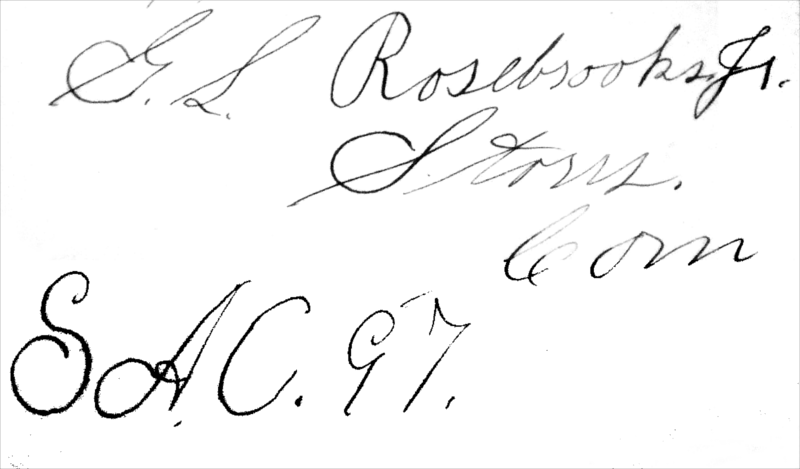
George L. Rosebrooks’s signature, accompanied by the annotations ‘Storrs, Conn’ and ‘SAC. 97’, in Elements of Chemistry.
The coursebook connection is even clearer in the case of the book Milk and its Products. The description of the course “Dairying” in the Storrs Agricultural College Catalogue: 1898-1899, reads “A short winter course in dairying. . . including composition of milk, conditions of creaming, milking for market, butter making, washing, salting, packing, etc. Breeding, feeding, and diseases of dairy cattle are subjects also treated in this course, with such texts as ‘ Milk and its Products,’ ‘ Bacteriology,’ and ‘Feeds and Feeding’”7, thus confirming the actual use of one of the books owned by George L. Rosebrooks in a Storrs Agricultural College course.
So those are a few things a book can tell you. Individually, these texts would perhaps have said little beyond their original subjects. Together, they form a context with each other, through their original owners, illustrating a history, be it local, academic, or familial. What one will find when conducting historical research is never certain, but in searching through the collections of two institutions, the University of Connecticut Archives and Special Collections as well as the Mansfield Historical Society in the search for this collection’s history and significance, I found far more significance to this collection than one would ever expect to find from a collection of century-old textbooks and readers.
-Daniel Allie
1 Durand, Robert. Storrs Family Pedigree Chart. Mansfield Historical Society digital record. Accessed 13 July 2016.
2 “George L. Rosebrooks.” In Commemorative Biographical Record of Tolland and Windham Counties. (Chicago: J.H. Beers & Co, 1903), 420.
3 “Financial Summary: Farm Receipts: Poultry, 1931.” University of Connecticut Agricultural Economics Records, Series VII, Subseries B, Box 42. University of Connecticut Archives and Special Collections, Thomas J. Dodd Research Center.
4 “Contracts.” In The Mansfield Poor House: A Forgotten Institution. (Mansfield: History Workshop of The Mansfield Historical Society, 1985), 7.
5 “Storrs Agricultural School: Report of F. Rosebrooks, For the Term Ending Mar. 29, 1889.” Ethel Larkin Papers, Mansfield Historical Society, Mansfield, Connecticut.
6 Connecticut College of Agriculture and the Mechanic Arts Catalogue 1899-1900, 25. University of Connecticut Archives and Special Collections, Thomas J. Dodd Research Center.
7 Storrs Agricultural College Catalogue: 1898-1899, 13. University of Connecticut Archives and Special Collections, Thomas J. Dodd Research Center.
The Fight for the Gun Control Act of 1968
This guest blog post is by Gabrielle Westcott, doctoral student in the Department of History at the University of Connecticut. Ms. Westcott received her B.A. in History from Whitman College and her M.A. in History from the University of Connecticut in 2015. Her research examines the influence of emotions and personality on twentieth-century U.S. foreign policy. As a 2016 graduate intern, she spent the summer learning about archival work and exploring the many political collections held at Archives and Special Collections.
In August 1963, after two years of investigation by the U.S. Senate’s Subcommittee on Juvenile Delinquency and three months before President Kennedy’s assassination, Senator Thomas J. Dodd introduced legislation to amend the Federal Firearms Act of 1938. The bill, S. 1975, addressed the ease with which juveniles and criminals could anonymously purchase mail-order guns and thus circumvent state laws regarding the sale of firearms. As it was first proposed, the bill sought to require individuals who wished to purchase a handgun to submit an affidavit, testifying to their eligibility to purchase a weapon in their home state. The seller would then send a copy of this affidavit to local law enforcement, who would have to authenticate the affidavit before the weapon could be sold. This was later amended so that the seller would simply provide notification of the intended delivery of the firearm to local law enforcement, without having to get police approval of the sale. After the death of President Kennedy, who was shot with a mail-order rifle purchased under a false name, Dodd amended the bill to require an affidavit for both handguns and long guns.
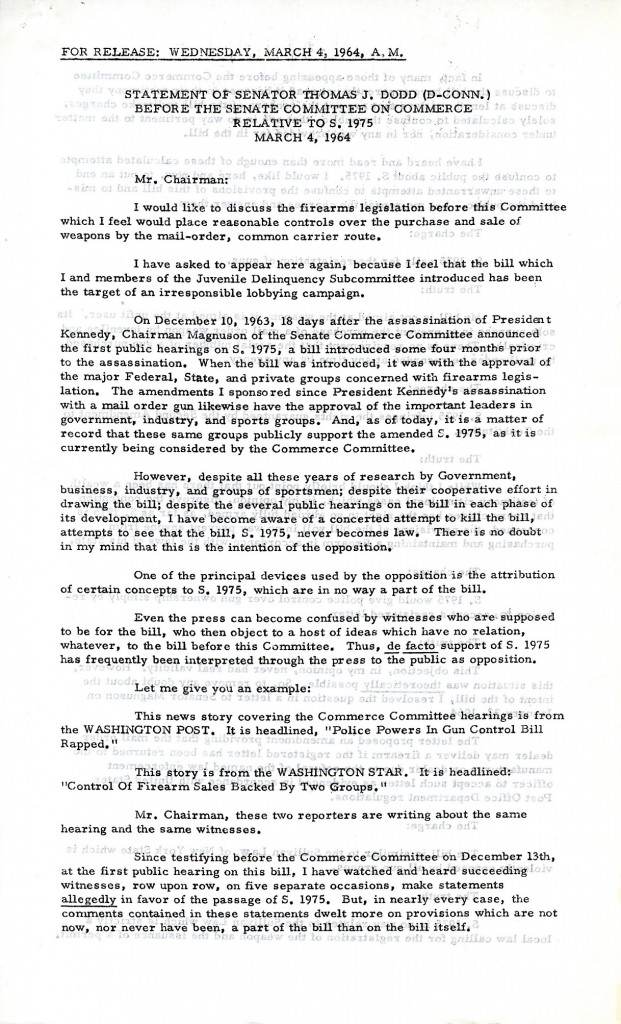 Yet, Kennedy’s assassination inspired criticism of Dodd’s bill on the grounds that it was nothing more than a hysterical reaction to the president’s death. Responding to these claims, Dodd emphasized in speech after speech that the provisions of the bill were the outcome of a two-year investigation, in which the Subcommittee on Juvenile Delinquency worked with arms manufacturers, arms dealers, law enforcement, sportsmen’s groups, the Department of Justice, and the Treasury Department. Furthermore, the bill had the support of each of these groups, and the executive vice president of the National Rifle Association testified to his organization’s support of the bill on multiple occasions.
Yet, Kennedy’s assassination inspired criticism of Dodd’s bill on the grounds that it was nothing more than a hysterical reaction to the president’s death. Responding to these claims, Dodd emphasized in speech after speech that the provisions of the bill were the outcome of a two-year investigation, in which the Subcommittee on Juvenile Delinquency worked with arms manufacturers, arms dealers, law enforcement, sportsmen’s groups, the Department of Justice, and the Treasury Department. Furthermore, the bill had the support of each of these groups, and the executive vice president of the National Rifle Association testified to his organization’s support of the bill on multiple occasions.
Despite widespread support, by the end of 1964 the bill was stalled in the Senate Commerce Committee. “What seems to be influencing some members of the Committee to withhold action on this bill,” Dodd noted, “are the protests of people who are either misinformed or bamboozled. In most cases these misinformed protesters have been misled by those who have financial interests in gun running, and by those who have suspect motives which are cloaked under the false cover of anti-Communism, or patriotism, or Constitutional liberties.”[1] Witnesses testifying before the Commerce Committee during the hearings on S.1975 expressed concern that the bill would lead to the registration of firearms. Because sellers would be required to send information about the purchaser’s identity and a description of the weapon to local law enforcement, one witness argued that “whatever regulatory body is chosen to interpret this requirement and draft the applications or forms involved will most assuredly ask for the serial number of the firearm involved. We submit that this is registration.”[2] The Washington Post reported that the National Wildlife Federation and the National Rifle Association opposed the bill’s requirement that the serial number of a gun be reported to law enforcement, while 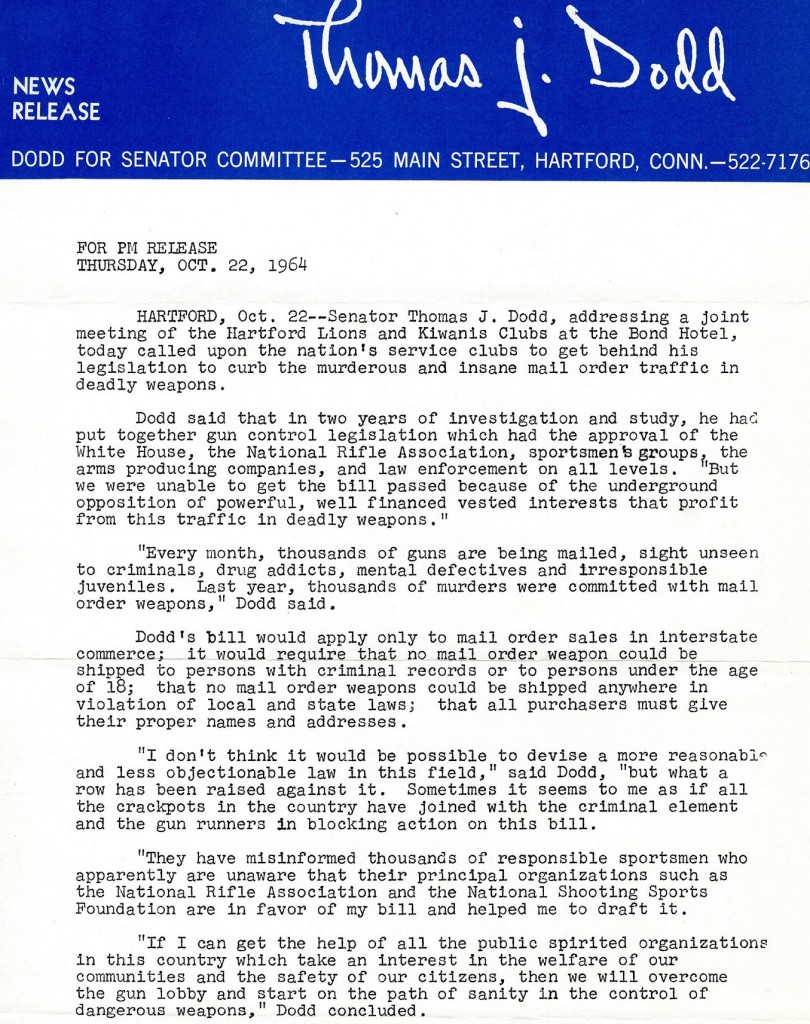 constituents writing to Dodd and members of the committee expressed concern over the “gun registration provisions” of the bill. Yet there were not, and never had been, gun registration provisions in the bill. Dodd testified to this fact in front of the Committee, noting, “My bill is not aimed at the weapon, it is aimed at the unfit user. . . . There is no requirement that the serial number of a gun purchased by mail order be recorded at any time by any agency.”[3] In the face of such opposition, S. 1975 died in committee. Determined to press on, Dodd reintroduced the bill to the 89th Congress on January 6, 1965 under the title S. 14.
constituents writing to Dodd and members of the committee expressed concern over the “gun registration provisions” of the bill. Yet there were not, and never had been, gun registration provisions in the bill. Dodd testified to this fact in front of the Committee, noting, “My bill is not aimed at the weapon, it is aimed at the unfit user. . . . There is no requirement that the serial number of a gun purchased by mail order be recorded at any time by any agency.”[3] In the face of such opposition, S. 1975 died in committee. Determined to press on, Dodd reintroduced the bill to the 89th Congress on January 6, 1965 under the title S. 14.
Two months later, on March 8, 1965, President Lyndon B. Johnson spoke to Congress and proposed a program to wage a war on crime that included controls on mail-order weapons. Seizing the opportunity for a stronger gun control bill provided by the president’s speech, Dodd introduced two bills on behalf of the administration, which Dodd noted, “call[ed] for controls more comprehensive and stringent than I dared to hope for.”[4] The proposed legislation prohibited mail-order sales to individuals, such that persons wishing to purchase a mail-order firearm would have to place their order through a licensed dealer. Furthermore, federally licensed importers, manufacturers, and dealers were prohibited from selling firearms, with the exception of rifles and shotguns, to anyone who was not a resident or businessman of the state in which the seller was located. Finally, federally licensed importers, manufacturers, and dealers were prohibited from selling any type of firearm to an individual under 21 years of age, although rifles and shotguns could be sold to individuals over the age of 18.
It would be three years before Dodd’s legislation prohibiting the interstate mail-order sale of handguns would finally pass in the form of Title IV of President Johnson’s Omnibus Crime Bill. The intervening years would be marked by increasing racial tension, the outbreak of riots in cities across the country, mass shootings, and the assassinations of Martin Luther King, Jr. and Robert F. 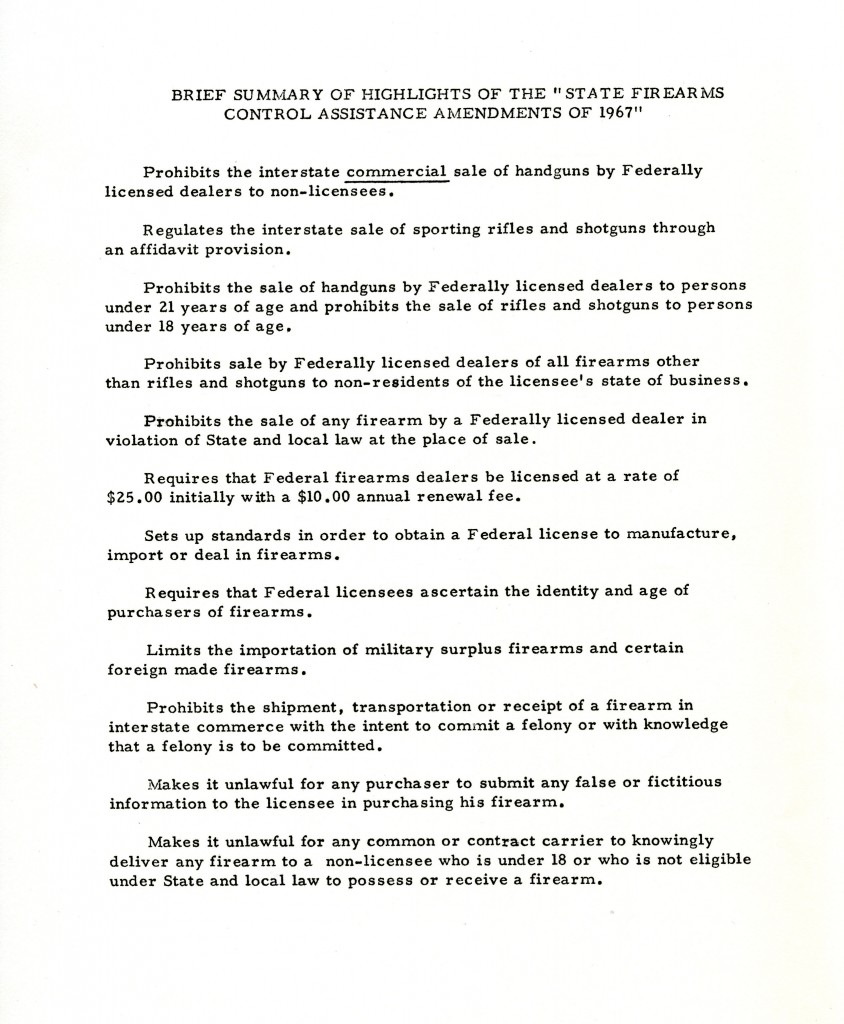 Kennedy.
Kennedy.
On August 1, 1966, a student at the University of Texas in Austin climbed to the top of the University of Texas Tower and opened fire, leaving 14 people dead and 31 people injured. It was the first mass campus shooting in the United States. The following day, Dodd urged Congress to take action on his firearms legislation, noting, “It is tragic indeed that those of us who call for stronger firearms control laws must rest our case on such headlines as these. How many times will we stand witness to such atrocities before we act? How many more people must die before the American public, the Federal Government and the Congress call in unison for effective firearms legislation?”[5] When two mass shootings occurred in New Haven in that same month, Dodd once again appealed to Congress. “It happened last week. It happened this week. It will happen next week. And it will continue to happen until there are stricter gun laws.”[6] 50 years later, in the wake of Aurora, Sandy Hook, Charleston, Orlando, and countless others, Dodd’s words should haunt us.
While much of the debate surrounding gun control focused on preventing “criminals, drug addicts, mental defectives, and irresponsible juveniles” from purchasing firearms, racial tension undoubtedly played a role in who was deemed fit to own a gun. In 1966, a group in California calling themselves the Black Panther Party for Self Defense began openly carrying firearms to protect African American communities against police brutality. At the time, there was no law prohibiting the open carry of a weapon in a public space. Responding to the actions of the Black Panthers, the California legislature proposed the Mulford Act, which would make it illegal to openly carry loaded weapons. The NRA, it should be noted, supported the legislation. On May 2, 1967, a group of armed Black Panthers entered the chamber of the California State Assembly and interrupted a legislative session to protest the Mulford Act. Speaking to the Senate, Dodd called the incident “a striking example of the need for effective gun control legislation. . . . These armed men serve as a chilling reminder that legislation should be passed swiftly to keep firearms out of such irresponsible hands.”[7] That same month, the NRA encouraged their members to arm themselves to act as “a potential community stabilizer” in the case of urban rioting.[8]
On June 6, 1968, the day after Robert F. Kennedy was assassinated, Johnson signed into law the Omnibus Crime Control and Safe Streets Act. Title IV of the Act prohibited the interstate mail-order sale of handguns; however, the amendment to prohibit the mail-order sale of rifles and shotguns was defeated. In the wake of Kennedy’s death, and with the support of the Johnson administration, Dodd introduced four new firearms control bills, calling for the inclusion of rifles and shotguns in the Omnibus Crime Control Bill, strict control over the sale of ammunition, the registration of all firearms, and the licensing of all firearms owners. Despite widespread public support for licensing and registration, opponents of gun control managed to remove those provisions from the final legislation. Signed into law on October 22, the Gun Control Act of 1968 was the culmination of five years of legislative effort and seven years of investigation on the part of Senator Dodd and the Subcommittee on Juvenile Delinquency.
-Gabrielle Westcott, August 2016
[1] “Press Release Concerning Interstate Weapons Traffic,” August 6, 1964, Thomas J. Dodd Papers, Box 200:5080, Archives and Special Collections, University of Connecticut.
[2] Interstate Shipment of Firearms: Hearings Before the Committee on Commerce, United States Senate, 88th Cong. 194 (1964), ProQuest Congressional Publications (Permalink: http://congressional.proquest.com:80/congressional/docview/t29.d30.hrg-1963-com-0043?accountid=14518) (accessed August 3, 2016).
[3] “Statement of Senator Thomas J. Dodd Before the Senate Committee on Commerce,” March 4, 1964, Thomas J. Dodd Papers, Box 198:5002, Archives and Special Collections, University of Connecticut.
[4] “Press Release Concerning Amendments to Federal Firearms Act,” March 22, 1965, Thomas J. Dodd Papers, Box 201:5180, Archives and Special Collections, University of Connecticut.
[5] “Press Release Concerning Need for Stronger Gun Control Legislation,” August 2, 1966, Thomas J. Dodd Papers, Box 204:5363, Archives and Special Collections, University of Connecticut.
[6] “Press Release Concerning a Shooting in New Haven, CT,” August 26, 1966, Thomas J. Dodd Papers, Box 204:5370, Archives and Special Collections, University of Connecticut.
[7] “Stronger Gun Laws Needed,” May 31, 1967, Congressional Record, Thomas J. Dodd Papers, Box 207:5550, Archives and Special Collections, University of Connecticut.
[8] “No Vigilantes, Please,” May 31, 1967, Congressional Record, Thomas J. Dodd Papers, Box 207:5501, Archives and Special Collections, University of Connecticut.
Black Experience in the Arts: Playwright Leslie Lee
-Guest blog post by Marc Reyes, doctoral student at the University of Connecticut and 2016 Summer Graduate Intern in Archives and Special Collections.
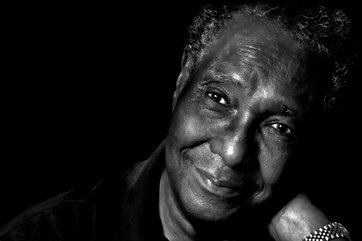 “Now, I am a black playwright; I am not a playwright who happens to be black…I am very happy writing about black people. I do not have to write about anybody else.”
“Now, I am a black playwright; I am not a playwright who happens to be black…I am very happy writing about black people. I do not have to write about anybody else.”
Those words were spoken by dramatist Leslie Lee, a renowned writer of stage and screen. When Lee was not scripting Tony Award-nominated plays or acclaimed television programs, he spoke to students about his life, writing career, and creative process. Lee visited the University of Connecticut on September 29, 1987 as a guest speaker for the university’s course, Black Experience in the Arts. The class, offered through the School of Fine Arts, debuted in the Fall semester of 1970 and lasted under this name until the mid-1990s. During the course’s lifetime, UConn undergraduates heard from hundreds of black artists, representing fields such as music, dance, poetry, sculpture, and architecture. Many of the invited presenters were performers with a myriad of memories and achievements as well as thoughts about what it meant to be a black artist in America. Course notes, typed lecture transcriptions, and over three hundred audio recordings are some of the materials found in Archives and Special Collections’ Black Experience in the Arts collection. This collection offers researchers an exciting look into a course dedicated to highlighting the contributions of black artists and the power of art as a mechanism for social change and racial expression. From this vantage point, scholars of the American experience gain a richer understanding of the black arts movement of the 1960s and 1970s and how black artistic expression was a crucial element of the civil rights and later black power movements.
When Lee spoke in the Fall of 1987, he was one of the few playwrights that addressed the class. Most of the speakers who represented black theater were actors or directors, but Lee offered insights into how a writer expresses their creative vision through different mediums. Of all the ways his writing was expressed – through films, television, and novels – his first love was theatre because it was the most verbal. He explained, “But in the theater it is my play and it is my vision, and those persons who are directing, or the set designers, or the costume designers, the lighting designers, the actors are an extension of me…” 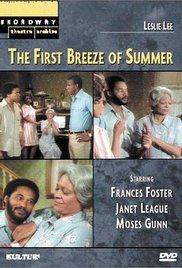
Besides discussing his career, Lee told students about his middle-class upbringing in Pennsylvania and how family members, like his grandmother, were inspirations for some of his play’s most memorable characters. He also explained how his interest in writing and the arts was not predestined, in fact, Lee confided to his audience that his artistic journey started later in life. Growing up he wanted to be a doctor and even spent years as a cancer researcher, but his passion for writing overwhelmed all else and he returned to school to study playwriting at Villanova University. After graduating, Lee worked as a writing instructor at several colleges and adapted for television Richard Wright’s Almos’ a Man. But his big break came with the staging of his 1975 play, “The First Breeze of Summer.” The production won three Obie Awards (the top honor for Off-Broadway productions) including Best New American Play and then moved to Broadway where it was later nominated for a Tony Award in the Best Play category.
In his lecture, Lee stressed to the students that to be a successful writer, one must have something important to say. Their voice must communicate a message that can even reach international audiences. With his voice, Lee strove to produce works that celebrated blackness and displayed the beauty of black bodies. He lamented seeing blacks thin their lips, alter their noses, and bleach or peel their skin to appear lighter. He remembered marching in the 1960s to the chants of “Black is Beautiful” and how the collective faith in that message erased the doubts he had about the beauty of black bodies. From that moment, he wanted his work to produce a similar feeling in black Americans. As for the characters found in Lee’s works, his heroes are the everyday black man or woman “who struggle daily against racism and against other things that are constantly impinging upon their consciousness.” Finding theatre to be the best avenue for exploring black consciousness, Lee developed an array of three-dimensional black characters that tackled issues such as systematic racism and the horrors of war.
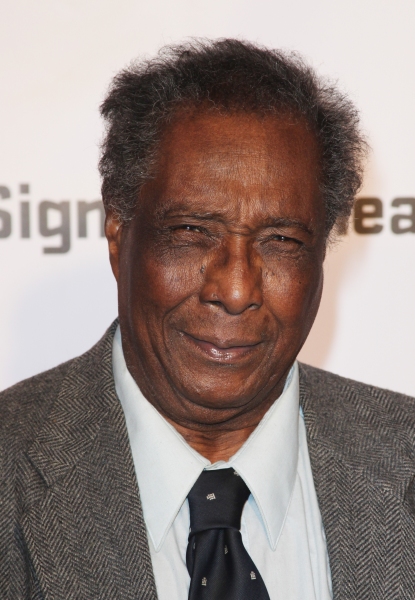 Beyond individual depictions, Lee was also concerned in the ways black families were depicted in the arts. He believed black families, like the ones found on The Jeffersons and Good Times, were almost always portrayed in comic lights, making it easier to not take black people, and their concerns, seriously. He recounted a story about a reviewer who saw his play “Hannah Davis,” which centered on the actions of an upper-class black family. Although the work received many positive reviews, one critic panned the play. The critic found the piece problematic because he could not envision that a well-to-do black family like this existed. Lee rejected the shallow criticism and informed the reviewer that the family in the play was based on a real black family, but the experience reinforced in Lee the need to project stronger images of black people and their families than the depictions usually found on television or motion pictures.
Beyond individual depictions, Lee was also concerned in the ways black families were depicted in the arts. He believed black families, like the ones found on The Jeffersons and Good Times, were almost always portrayed in comic lights, making it easier to not take black people, and their concerns, seriously. He recounted a story about a reviewer who saw his play “Hannah Davis,” which centered on the actions of an upper-class black family. Although the work received many positive reviews, one critic panned the play. The critic found the piece problematic because he could not envision that a well-to-do black family like this existed. Lee rejected the shallow criticism and informed the reviewer that the family in the play was based on a real black family, but the experience reinforced in Lee the need to project stronger images of black people and their families than the depictions usually found on television or motion pictures.
Leslie Lee’s September 1987 visit to UConn’s Black Experience in the Arts class discussed the personal and artistic fulfillment that can be found in the performing arts and encouraged students to consider a career in drama and make a home in black theatre. For interested students, he referred to the Negro Ensemble Company which produced many of Lee’s plays and has been a training ground for black actors such as Lawrence Fishburne, Angela Bassett, and Denzel Washington. Lee asserted that more black writers and actors were needed to produce multi-dimensional and complex black characters. He also wished black students would pursue theatre criticism because he believed black critics would bring greater insights when evaluating the works of black playwrights.
There are many more exciting ideas and profound lessons found in Lee’s lecture which can be explored in the Black Experience in the Arts collection at Archives and Special Collections. Stay tuned as we continue to make these valuable materials more widely known and available as well as additional blog posts highlighting other prominent lecturers who visited the university and spoke to students about the Black Experience in the Arts.
Marc Reyes is a doctoral student in the Department of History at the University of Connecticut. He received his B.A. in History from the University of Missouri and his M.A., also in History, from the University of Missouri-Kansas City. His research investigates the United States and its interactions – diplomatically, economically, and culturally – with India. As a 2016 graduate intern, Marc is excited to gain additional experience working in a university archive and will be exploring the history of the Black Experience in the Arts course here at UConn as well as the broader movement of 20th century black expression in the arts.
#AIDS35
-Guest blog post by Thomas Lawrence Long, Associate Professor and co-curator of the AIDS35 exhibition on display in the John P. McDonald Reading Room, Archives & Special Collections during the months of August and September, 2016.
In 2016 we mark the thirty-fifth anniversary of the first published reports of what would come to be called the AIDS epidemic. Initially identified as rare cancers among gay men, Haitian immigrants, intravenous drug users, and hemophiliacs, AIDS emerged at a moment when a triumphant religious right (organized by the so-called Moral Majority) and political conservatives dominated American media and public life. The convergence of a mysterious infectious disease associated with stigmatized groups or behaviors, on the one hand, and a moralistic neo-liberal social and political movement, on the other hand, created the conditions for competing published representations. These representations invoked divine judgment and apocalyptic anxiety, or critiques of conservative medical authorities and of defunded public health resources.
HIV, the virus causing AIDS, is often transmitted by proscribed behaviors: sexual intercourse (both vaginal and anal) and intravenous drug use. HIV-infected people were thus routinely blamed for their infection and stigmatized as a threat to the general population. Even among gay men for whom sexual liberation was associated with social and political freedom, the AIDS epidemic created a crisis of confidence.
In a paper presented in 1986 at the annual convention of the Modern Language Association and later published in 1988, communication and cultural theorist Paula Treichler, analyzing the representational conflicts surrounding AIDS, observed that “the AIDS epidemic is simultaneously an epidemic of a transmissible disease and an epidemic of meanings or signification. Both epidemics are equally crucial for us to understand, for, try as we may to treat AIDS as ‘an infectious disease’ and nothing more, meanings continue to multiply wildly and at an extraordinary rate.”
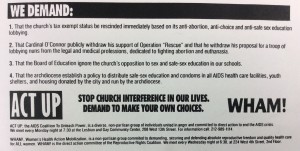 To wrest control of the epidemic’s representational field, AIDS activists, independent queer presses, and AIDS service organizations produced a variety of publications, including safer-sex brochures, tracts and manifestos, zines, and AIDS-themed fiction. Items included in this exhibit come both from Archives and Special Collections and the personal collection of Associate Professor in Residence Thomas Lawrence Long.
To wrest control of the epidemic’s representational field, AIDS activists, independent queer presses, and AIDS service organizations produced a variety of publications, including safer-sex brochures, tracts and manifestos, zines, and AIDS-themed fiction. Items included in this exhibit come both from Archives and Special Collections and the personal collection of Associate Professor in Residence Thomas Lawrence Long.
Ironically, this year marks another AIDS anniversary: twenty years since the introduction of protease inhibitors and other retroviral drug combinations that turned HIV infection from a death sentence to a manageable chronic infection.
For more information on campus wide exhibitions and programming on #AIDS35, click here.
-Thomas Lawrence Long, Associate Professor in residence in the UConn School of Nursing with a joint appointment in Women’s, Gender, and Sexuality Studies, is the author of AIDS and American Apocalypticism: The Cultural Semiotics of an Epidemic. He is a founding member of the Modern Language Association’s Medical Humanities and Health Studies Forum and an associate editor of Literature and Medicine.
Are Photographs a Truly Reliable Primary Source?
Do you notice something different about these two images?
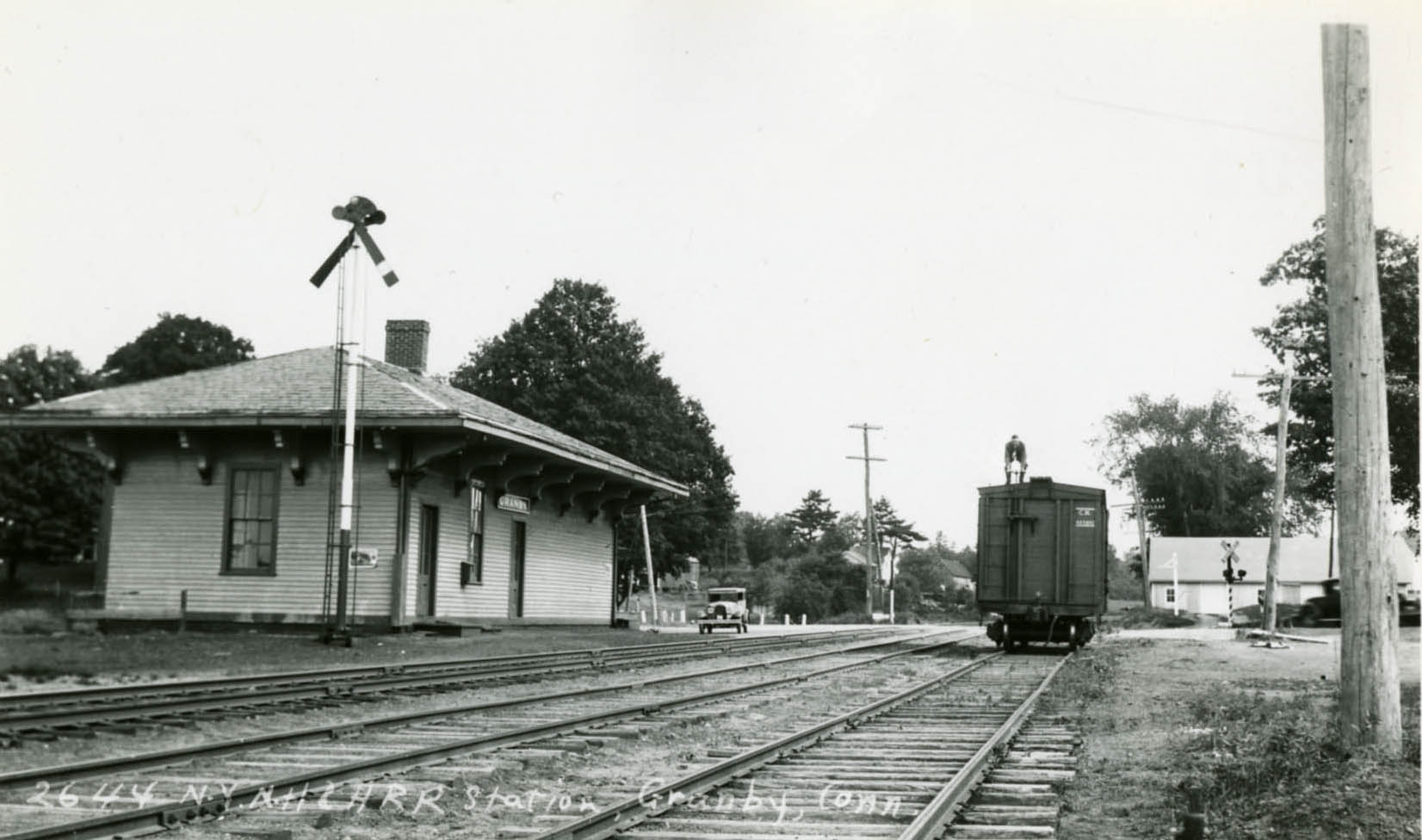 I’m sure you see it — in the second photograph there is a man standing on top of the box car. These two digital images are from the same actual, physical object of a photographic print. What do you think happened here?
I’m sure you see it — in the second photograph there is a man standing on top of the box car. These two digital images are from the same actual, physical object of a photographic print. What do you think happened here?
It’s an interesting story. This photograph, of the Granby, Connecticut, railroad station, was taken around 1930 by the noted regional photographer Lewis H. Benton, who was born in Taunton, Massachusetts, in 1872 or 1873 and worked for the New York, New Haven & Hartford Railroad as a clerk. In his free time he would travel around the region with his sidekick Irving Drake and take photographs of railroad stations and structures. In both versions of the photograph you will see Mr. Drake’s sedan near the station; in the second image that’s him on top of the railroad car. This image was donated along with thousands of other photographs of railroad locomotives, stations, and scenes by Mr. Francis D. Donovan of Medford, Massachusetts, in 2006.
Recently we had a visit to the archives of Mr. Robert Belletzkie, a very knowledgeable railroad historian who maintains a website focusing on railroad stations in Connecticut — TylerCityStation.info. Mr. Belletzkie was conducting his research in the Donovan Papers, saw the photograph, the version without Mr. Drake on top of the car, and knew something was wrong. He had seen this same image before in other collections (which is not uncommon; railroad photograph collectors routinely make copies and share the prints among themselves) but he knew the photograph to have the image of Mr. Drake on top of the box car.
Mr. Belletzkie brought the photograph to my attention and we took a close look at it. A small dot of white-out had been placed on the print to cover up the image of Mr. Drake in the photo. How intriguing! Who would have done that, and why? It was certainly done before the collection was donated to Archives & Special Collections. Did Mr. Donovan do it? Did someone do it before that particular print made its way to Mr. Donovan?
Mr. Belletzkie offers this explanation — “Whoever covered up Mr. Drake thought it was inappropriate for him to be seen posturing in a serious station photograph or perhaps even that Mr. Benton was unaware of him up there and did not intend him to be in the shot. A larger study of the Benton & Drake photos currently underway, however, shows several shots with a similar, humorous touch. The eradicator’s sense of propriety may have been offended but anyone who retouches historical photographs does a disservice to future generations by not passing on something exactly as its creator intended.”
Well, who or however it happened, I wanted to set the record straight. Yesterday I gave the print to the UConn Library’s Conservation Librarian, Carole Dyal, who expertly scraped off the white-out to reveal Mr. Drake on top of the railroad car.
We’ve come to expect that photographs reveal the truth of any historical moment. Sometimes we have to remember that photographs can be altered and obscured, which affects our knowledge of historical events.
Our Comics, Ourselves Gallery Event
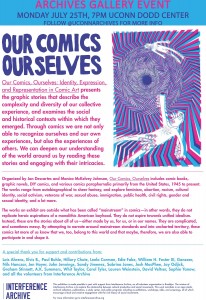 The Archives & Special Collections will be hosting a Gallery Event on Monday, July 25th at the Thomas J. Dodd Research Center on the University of Connecticut, Storrs Campus at 7pm. Co-Curator and webcomic creator Jan Descartes will lead the event to discuss DIY comics, art and social justice issues represented in the Our Comics, Ourselves exhibition currently on display in the Thomas J. Dodd Research Center, on loan from the Interference Archive in Brooklyn, NY until August 22nd, 2016.
The Archives & Special Collections will be hosting a Gallery Event on Monday, July 25th at the Thomas J. Dodd Research Center on the University of Connecticut, Storrs Campus at 7pm. Co-Curator and webcomic creator Jan Descartes will lead the event to discuss DIY comics, art and social justice issues represented in the Our Comics, Ourselves exhibition currently on display in the Thomas J. Dodd Research Center, on loan from the Interference Archive in Brooklyn, NY until August 22nd, 2016.
This event is free and open to public. Parking is available on Whitney Road and behind the Thomas J. Dodd Research Center after 5pm.
For further information, please follow us on Twitter or contact Archivist Graham Stinnett
Reading Room Closed Monday July 4
The Archives and Special Collections Reading Room, and the University, will be closed this Monday, July 4 for the federal holiday. Regular Reading Room hours of 9:00am to 4:00pm resume on Tuesday, July 5.


